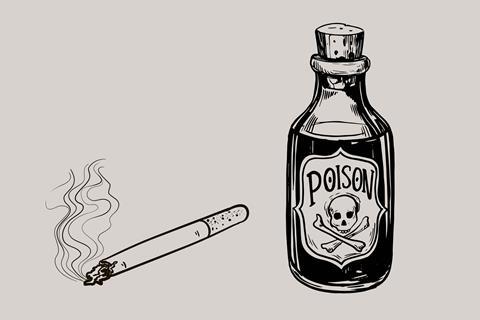It could be lights out when you light up…

A murder weapon that self-destructs. It’s like something out of a spy story or an elaborate crime drama. And one such weapon has had a long career in the spotlight. A few of its credits include the 1940s American movie Bermuda Mystery and the classic detective show Colombo, with more modern roles in Breaking Bad, SS-GB and Murder in Paradise. But it’s not an elaborate high-tech invention of a spymaster or genius criminal. It’s the simple cigarette. Or indeed the cigar, pipe or the modern-day heated tobacco product (HTP). Tobacco products have claimed the lives of many consumers, but when laced with faster-acting toxins their potential for getting away with murder is clear: the victims administer the poison themselves as the evidence goes up in smoke. It’s a perfect fictional plot device – and it also stars in real-life crimes.
This summer, a care worker in Pennsylvania used poisoned cigarettes in an attempt to murder the elderly couple she was supposed to be caring for. The motive was straight out of a crime drama: she had power of attorney for the couple and stood to inherit their money, but she had fallen out with them over the couple’s accusations she had forged their signatures on cheques. Frustrated by the possibility of being fired and losing the inheritance, she added a special ingredient when she rolled the couple’s cigarettes: pieces of rat poison from a green bait block.
This summer, a care worker in Pennsylvania used poisoned cigarettes in an attempt to murder the elderly couple she was supposed to be caring for.1 The motive was straight out of a crime drama: she had power of attorney for the couple and stood to inherit their money, but she had fallen out with them over the couple’s accusations she had forged their signatures on cheques. Frustrated by the possibility of being fired and losing the inheritance, she added a special ingredient when she rolled the couple’s cigarettes: pieces of rat poison from a green bait block.
If a product like Fastrac Blox was used, the particular poison the couple was exposed to was bromethalin, a compound designed to kill rodents in a single dose. This rodenticide is odourless, essentially insoluble in water, and a potent neurotoxin. The liver metabolises bromethalin to form the even more potent desmethylbromethalin (DMB). DMB disrupts the normal sodium–potassium gradient of the central nervous system, which can increase the pressure of the cerebrospinal fluid and cause cerebral oedema. This build-up of fluid and pressure crushes nerves, causing paralysis, convulsions, and, in cases of acute exposure to the poison, death follows in a day or two.
Human bromethalin exposures are rare and worst case scenario outcomes are rarer still, which is good news. But the rarity of such poisoning events means the analytical options available to identify the poison are limited. Bromethalin’s popularity as a rodenticide, along with the potency of DMB, continues to motivate the development of new methods that can detect the poison in animal tissue samples. One promising method is based on reverse-phase ultrahigh-performance liquid chromatography−mass spectrometry.
And the Pennsylvania case also adds inhalation as route of exposure, which is almost unheard of. Luckily, the elderly husband and wife lived to tell their tale. The cigarettes tasted off, which prompted the woman to inspect them and the stash of tobacco. In both, she found unusual bits of green material – the crushed up rat poison. The care worker confessed and was charged with reckless endangerment, aggravated assault and attempted murder.
A recent Japanese case combined a more modern HTP device with a very old poison: mercury. Criminal mercury poisoning is nothing new, but in this case the investigators noted the method of delivery is ‘strange and novel … the first case of mercury vapor poisoning using HTP’. The intended victim received a gift of 20 cigarettes from an acquaintance. Working through the pack, they began to feel ill. On the 14th cigarette, he ‘noticed a small silver object’ that dislodged itself from the cigarette. Subsequent visits to the police station and hospital revealed the identity of the ‘object’, and the gift-giving killer spilled the details of his murder plot. Again, the victim survived.
But not all victims are so lucky, such as the victims of Irmgard Swinka. In May 1949, Swinka was sentenced for poisoning five women across West Germany using ‘poisoned cigarettes and drugs’. Like the Pennsylvania care worker 70 years later, Swinka’s motive is thought to have been money. She was reportedly the last person sentenced to death in West Germany, although she instead received a long prison sentence after the death penalty was abolished.
Poisoned cigarettes or cigars also feature in cases of political intrigue and espionage. A botulinum toxin-contaminated cigar was supposedly considered for assassinating Fidel Castro. South Africa’s so-called ‘Dr Death’, Wouter Basson, is alleged to have designed numerous deadly schemes as part of apartheid’s chemical and biological warfare programme – including poisoned cigarettes.
The poisoned cigarette or cigar is not an urban myth, but an all-too-real weapon.

















No comments yet